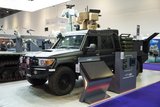Northrop Grumman's next-generation FBCB2 system approved for fielding
FBCB2 is the key situational awareness and command-and-control system used by US and coalition forces. More than 95,000 FBCB2 systems have been deployed worldwide, forming the world's largest tactical network. The system has been successfully fielded for 16 years.
JCR will be incorporated into the LandWarNet/Battle Command Baseline for fielding to deploying units scheduled to receive software block 2.
JCR upgrades include an increase in network bandwidth that allows the system to move more information to more users within seconds rather than in minutes. JCR also provides a common FBCB2 platform solution for both the Army and US Marine Corps.
"The ability to receive and share battlefield data through a broad-based, reliable network is increasingly important and critical to the mission. JCR provides new collaboration tools and other enhancements that are orders of magnitude more capable than what is available to soldiers and Marines today," said Joe G. Taylor, Jr., vice president of the Ground Combat Systems business unit within Northrop Grumman's Information Systems sector.
The system includes Blue Force Tracking 2 (BFT 2), a high-tech, high-speed force-tracking satellite-communications network. The Army says BFT 2 will be roughly 10 times faster than the existing BFT system. When JCR is fielded with the new BFT 2 transceiver and network upgrade, friendly positions will be updated in seconds.
With JCR, warfighters will also be able to share more broadly critical, sensitive information. The BFT 2 will include a new Programmable In-Line Encryption Device that is fully compatible with JCR.
Other new JCR capabilities include the Commercial Joint Mapping Tool Kit and an over-the-air self-descriptive situational awareness (SDSA) capability. SDSA will eliminate inflexible fixed databases and allow FBCB2-equipped units to change task organizations in the field to meet new mission requirements.
JCR represents a major departure from the original FBCB2 architecture. The new JCR approach is called the "Battle Command Product Line" (BCPL) and is designed to correct the "stovepipe" development approach taken by earlier command and control systems. Properly executed, BCPL will enable the Army to develop, test, certify and deploy software capabilities more quickly and at a lower cost.
The version that will be fielded is JCR-Vehicle L-Band (v) 1.1.1.4 V-4. The Army and Marine Corps are currently testing JCR V1.3.1 and considering it for a fielding upgrade this year.
FBCB2 links communication devices, sensors, vehicles, rotary-wing aircraft and weapons platforms in a seamless digital network to provide a clear, continuous and common picture of the battlefield. Most FBCB2 systems communicate via a satellite-based network; about 30 percent use the Enhanced Position Location Reporting System, or EPLRS, tactical radio network.
Northrop Grumman Corporation was awarded the first FBCB2 development contract in January 1995.
Source: Northrop Grumman
More from Digital Battlespace
-
![Babcock nears first customer for Nomad AI translation tool]()
Babcock nears first customer for Nomad AI translation tool
Nomad can provide militaries with real-time intelligence, saving critical time on the battlefield.
-
![AUSA 2025: Israel’s Asio Technologies to supply hundreds of improved Taurus tactical systems]()
AUSA 2025: Israel’s Asio Technologies to supply hundreds of improved Taurus tactical systems
Taurus operates alongside the Israel Defense Forces’ Orion system which supports mission management across tens of thousands of manoeuvring forces, from squad leaders to battalion commanders.
-
![AUSA 2025: Kopin pushes micro-LED plans as China moves faster]()
AUSA 2025: Kopin pushes micro-LED plans as China moves faster
The plan for the new displays follows fresh investment in Kopin’s European facilities by Theon and an order for head-up displays in fielded aircraft, with funding from the US Department of Defense.
-
![AUSA 2025: Persistent Systems to complete its largest order by year’s end]()
AUSA 2025: Persistent Systems to complete its largest order by year’s end
Persistent Systems received its largest ever single order for its MPU5 devices and other systems earlier this month and has already delivered the 50 units to the US Army’s 4th Infantry Division.
-
![Aselsan brings in dozens of companies and systems under the Steel Dome umbrella]()
Aselsan brings in dozens of companies and systems under the Steel Dome umbrella
Turkey has joined the family of countries attempting to establish a multilayered air defence system with government approval in August 2024 for the effort landed by Aselsan. Dubbed Steel Dome, the programme joins Israel’s Iron Dome, the US Golden Dome, India’s Mission Sudarshan Chakra and South Korea’s low-altitude missile defence system.
-
![DSEI 2025: MARSS unveils new agnostic multidomain C4 system]()
DSEI 2025: MARSS unveils new agnostic multidomain C4 system
MARSS’ NiDAR system has been deployed using sensors from static platforms to provide detection and protection for static sights, such as critical infrastructure, ports and military bases.




























